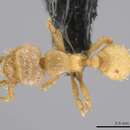fi
nimet breadcrumb-navigoinnissa


This species occurs in lowland wet to moist forest, from 200–575 m elevation. The recent collections are all from Winkler samples of sifted litter and rotten wood on the forest floor. Among the Project LLAMA specimens, seven are dealate queens and only two are workers, mostly from separate samples. This could reflect subterranean habits of the workers, with new queens dispersing up into the litter layer.
Cuba, Honduras to southern Mexico
Worker (based on two workers from Tikal National Park, Guatemala). HW 0.38–0.39 (n=2); mandible with two closely-spaced, very short teeth at base, these basal teeth with broad confluent bases, either with distinct denticulate apices or completely confluent and forming a low lamina at base, a small denticle about mid-distance between basal teeth and base of subapical tooth, reclinate denticle at base of subapical tooth absent, subapical tooth shorter than width of mandible at base, only slightly longer than subapical tooth, intercalary teeth present but minute; labrum about as long as broad, with two long, bluntly triangular lobes, sinus between them deep, length of anterolateral lobe longer than or about equal to distance from base of sinus to transverse carina at base of labrum; anterior clypeal margin concave; erect setae on leading edge of scape stiff but narrow, hardly clavate, unlike the squamiform setae typical of many other species; arcuate promesonotal groove and metanotal groove weakly impressed; propodeal tooth right angled, infradental lamella thin, evenly and shallowly concave; first gastral tergite with sparse squamiform setae on posterior half, one specimen with five setae on posterior margin and three anteriorly, one specimen with seven and five, respectively.
Queen. HW 0.40–0.54 (n=5); mandible and labrum similar to worker; face shape similar to worker but with grooves and ridges more shallowly impressed; compound eye shorter than maximum width of scape, with 5-6 facets across longest axis; ocelli small, cuticle adjacent to ocelli marked with black pigment spots on evenly light brown background; shape of propodeal tooth, petiole and postpetiole similar to worker; shape of infradental lamella variable (see Comments); katepisternum and anepisternum large, convex, separated by broad groove; pubescence layer of abundant, short, curved setae covers mandible, face, scapes, legs, dorsal mesosoma and metasoma; abundant stiff erect setae on face, anterior edge of scape, side of head, dorsal mesosoma, dorsal gaster.
The male is unknown.
Rhopalothrix weberi is een mierensoort uit de onderfamilie van de Myrmicinae.[1][2] De wetenschappelijke naam van de soort is voor het eerst geldig gepubliceerd in 1960 door Brown & Kempf.
Bronnen, noten en/of referentiesRhopalothrix weberi é uma espécie de formiga do gênero Rhopalothrix, pertencente à subfamília Myrmicinae.[1]
Rhopalothrix weberi é uma espécie de formiga do gênero Rhopalothrix, pertencente à subfamília Myrmicinae.